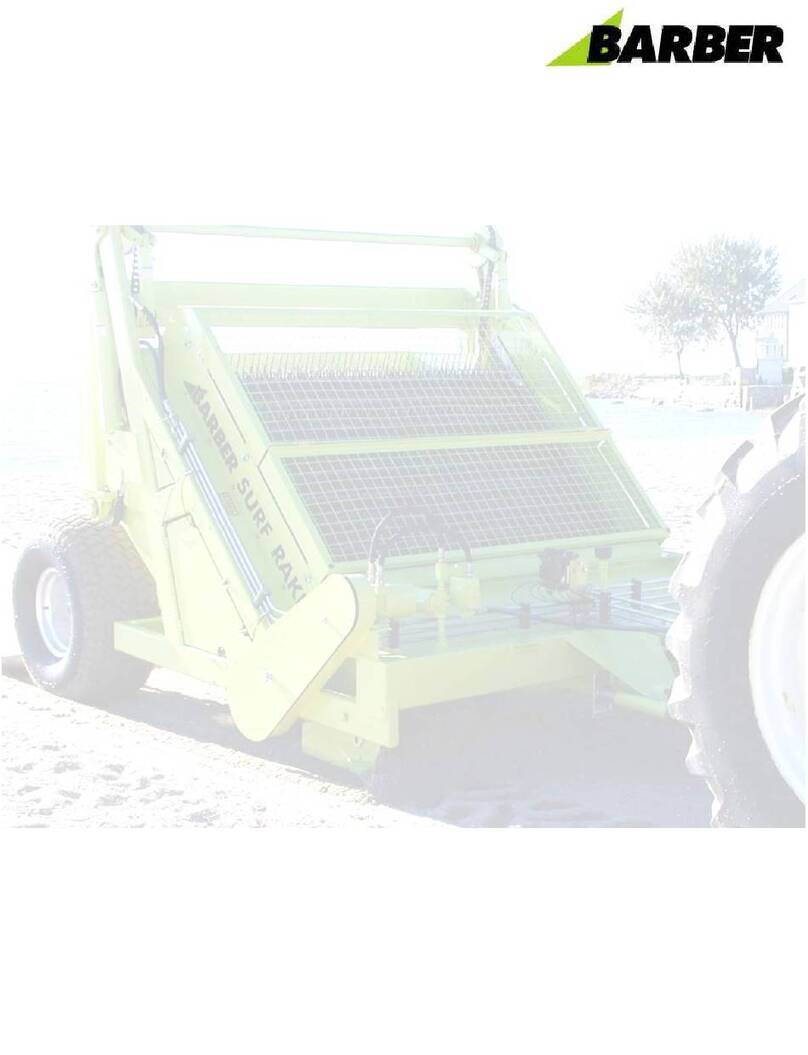
4780 0318
to the drive chain and the drive sprockets located inside the chain case.
Drive chain should be adjusted so that there is approximately 1/4"(6.35mm) slack but no more than
1"(25.4mm) slack midpoint between the sprockets. Adjustment is made by loosening the two bolts that
fasten the motor mount to the front tank motor bracket and tightening the adjusting bolt, which will move the
motor and attached front sprocket assembly forward. When adequate adjustment can nolongerbeachieved
in this manner, a half-link should be removed from the chain. Note: Chain tension should be ¼” minimum
(6.35 mm) and 1” maximum (25.4 mm).
BUCKET The bucket catches the debris the conveyor belt picks up. When full, the bucket is tripped,
pivoting on the lift arm and bucket bearings. There is a bucket stop on the right side, which stops the bucket
from rotating at its dumping position and prevents the bucket from spinning and over turning. When the
bucket is in its correct nesting position, the blocks should be to the bottom of the guides and slightly off the
frame.
HUB ASSEMBLY, WHEEL AND TIRE The two hub assemblies are attached to the
frame by the spindle. The hub rides on two races and bearings that can be adjusted as
they wear with the adjusting castle nut and pin. There is a refillable grease reservoir on
each hub that maintains pressure to the bearings.
Torque the lugs on the wheel and tire assemblies to 90 ft/lbs. The tires are inflated to 18
PSI. It is important that both tires be the same pressure.
FINISHER (OPTION) The grooming finisher is attached to the rear of the Surf Rake®to
smooth the clean sand and eliminate tire marks left by the tractor and beach cleaner. Always raise the
finisher before backing up the machine.
HYDRAULIC COMPONENTS (CONVEYOR)
The conveyor hydraulic system is separate from the bucket or finisher hydraulic systems. It is a closed
system made of the following components:
A reservoir of hydraulic fluid on the front of the Surf Rake®
A hydraulic pump, attached to and powered by the tractor PTO, which circulates the hydraulic fluid
The flow control, which regulates the flow of the hydraulic fluid through the motor
The conveyor belt motor that turns the chain case drive chain and sprockets and turns the conveyor
The hydraulic fluid is then filtered and returns back to the Surf Rake®reservoir
HYDRAULIC RESERVOIR The reservoir tank is located across the front of the frame. It supplies hydraulic
fluid to the hydraulic pump and conveyor belt drive motor. It has a magnetic drain on the bottomforchanging
the hydraulic fluid. There is a sight gage for inspecting hydraulic fluid level on the side of the tank.
BREATHER CAP The breather cap on top of the reservoir is pressurized to keep outcontaminantsandkeep
fumes from entering the atmosphere. It has a 10 micron rating and has a 5 PSI relief valve setting.
HYDRAULIC PUMP The hydraulic pump should be placed over the PTO spline shaft at
the rear of the tractor. Slide the pump as far forward as possible. The pump bracketcan
be mounted directly to the top link of the three point hitch. Adjust arms to keep the pump
upright and as close as possible to the tractor. If this bracket cannot be attached, use
the bracket with mounting chain. To secure the pump, secure the chain toarigidsurface
of the tractor, preferably to the pin of the upper three-point hitch arm bracket, so that the
torque arm of the pump is positioned up. The PTO spline will turn clockwise and the
resulting torque will tend to turn the pump clockwise also. Minimize the length of the
safety chain. There is a removable link that attaches the hook to the chain. This link may be repositioned
along the chain to minimize the chain length and maintain the upright orientation of the pump. It may be
necessary to reduce the chain length to achieve proper orientation of the pump. It may also be necessaryto
reposition the pump arm to fit up with the tractor. Be careful not to crimp or twist the hoses. If the 1"(2.54cm)
CHAIN TENSION
FLOW CONTROL





























